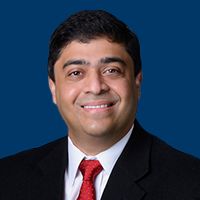Article
Multiple Myeloma Treatment Advances Promote a Future of Individualized Patient Care
Author(s):
Jeffrey V. Matous, MD, highlights takeaways from the phase 3 IKEMA trial and notes the benefits of administering CAR T-cell therapy in earlier lines, as evidenced in primary results from the phase 3 CARTITUDE-4 trial.
Jeffrey V. Matous, MD

Choosing optimal treatments for patients with multiple myeloma requires a clear knowledge of individual patient needs, as well as a realistic understanding of treatment access, according to Jeffrey V. Matous, MD, who noted that factors like location and financial toxicity affect whether patients can receive CAR T-cell therapy and other treatments.
“We have many choices, many drugs we can mix and match,” Matous said in an interview with OncLive® following a State of the Science Summit™ on myeloma, which he chaired. “It takes a fair amount of creativity to pick the right regimen for our patients.”
In the interview, Matous highlighted takeaways from the phase 3 IKEMA trial (NCT03275285), which showed that isatuximab-irfc (Sarclisa), carfilzomib (Kyprolis), and dexamethasone generated a 42% reduction in the risk of progression or death vs carfilzomib plus dexamethasone in patients with relapsed disease.1 He also noted the benefits of administering CAR T-cell therapy in earlier lines, as evidenced in primary results from the phase 3 CARTITUDE-4 trial (NCT04181827), in which ciltacabtagene autoleucel (cilta-cel; Carvykti) led to a 74% reduction in the risk of progression or death vs standard of care in patients with multiple myeloma who had received 1 to 3 prior lines of therapy.2
Additionally, Matous, a member physician at Colorado Blood Cancer Institute and a clinical professor of medicine at University of Colorado in Denver, discussed other key points from the meeting, including the development of cereblon E3 ligase modulators (CELMoDs), treatment sequencing with bispecific antibodies, and approaches to mitigate or avoid treatment-related toxicities in patients with multiple myeloma.
OncLive: What factors should clinicians consider when selecting therapies for patients with relapsed/refractory multiple myeloma who have received 1 to 3 prior lines?
Matous: There are many factors we consider when we’re evaluating a patient for relapsed/refractory multiple myeloma. They include comorbidities, prior therapy, response [to that prior therapy], and what their relapse is like. Is it an indolent biochemical relapse where we have time to think it over, or is it an aggressive fulminant relapse, where we need to choose a therapy that works quickly? Does the patient have neuropathy? Are there financial concerns? What’s their disease risk? We process all these when selecting regimens for patients in the second, third, or fourth lines.
What has been seen with the addition of isatuximab to carfilzomib and dexamethasone in patients with relapsed/refractory myeloma?
The IKEMA trial [investigated] isatuximab, carfilzomib, and dexamethasone. This is a potent regimen with significant PFS advantages for patients vs the doublet [of carfilzomib and dexamethasone] and some older regimens. It’s a well-tolerated regimen with high response rates and durable responses. It’s an excellent [regimen] to consider, especially if a patient has not recently received carfilzomib or a CD38-directed antibody.
As agents that target GPRC5D and other novel targets continue to be developed, how could the presence of targeted CAR T-cell therapies for multiple myeloma affect the treatment paradigm?
We’re already seeing that. The initial target that expanded and exploded in myeloma was BCMA on the surface of the cells. Some patients have received either CAR T cells targeting BCMA, or bispecific T-cell redirecting antibodies against BCMA, and then had disease recurrence. How do we treat those patients?
One option is to retreat with a BCMA-targeted agent, but it’s attractive to target different antigens on the surface of malignant plasma cells. That’s where targets like GPRC5D or FCRH5 come into play, or, in early development, we’re studying CD18, and CD38 again, as well as dual targeting CAR T cells. Having different antigens to target is attractive in these patients. At [the Colorado Blood Cancer Institute], we have treated patients who have progressed on a BCMA-targeted therapy with GPRC5D CAR T cells, with excellent results so far.
How might barriers to receiving CAR T-cell therapy be addressed to ensure patients receive these treatments quickly and avoid disease progression while waiting for CAR T-cell infusion?
I tell patients it will be roughly 5 weeks until their autologous CAR T cells are ready for administration. During that time, some patients have stable disease, and they can go without bridging therapy. However, other patients have more aggressive disease and require bridging therapy. Some patients in clinical trials have come off the studies and could not receive the CAR T-cell therapy because of aggressive disease progression.
Turning around CAR T cells faster, or getting them off the shelf, in the case of allogeneic CAR T cells, is attractive. Different groups around the world are doing this. At the 2023 ASCO Annual Meeting, a group from Dana-Farber Cancer Institute [in Boston, Massachusetts], presented preliminary data investigating rapid CAR T cell turnaround. [Groups in China are also] working on this. I hope in the future, this will be the norm.
As CAR T-cell therapies are approved in later lines in patients with multiple myeloma, how could the availability of these agents in earlier lines improve infusion wait times and rates of disease progression prior to receiving these therapies?
Hopefully, if you give [these agents] in the second or third line compared with [in a later line], the disease may be under better control in some patients. [Their] T-cell repertoire may be better, as well as their [ability to tolerate these] treatments. CAR T-cell therapy is a tough therapy. Giving these therapies earlier will make a difference.
[When comparing] the long-term [phase 1/2] CARTITUDE-1 trial [NCT03548207] data, which resulted in the FDA approval of cilta-cel [in 2022], with the data from the CARTITUDE-4 trial, which [used the agent] in earlier lines, we saw better outcomes and tolerability. That will be the way to go.
Regarding the presentation by Thomas G. Martin, MD, of the University of California San Francisco Helen Diller Family Comprehensive Cancer Center, how might CELMoDs fit into the multiple myeloma treatment landscape?
The way I explain CELMoDs to patients is they are like a new-and-improved pomalidomide [Pomalyst], lenalidomide [Revlimid], or thalidomide [Thalomid] that are more potent and will hopefully have a different and more favorable adverse effect [AE] profile. Eventually, they may replace some immunomodulatory drugs. Although T-cell redirecting therapies are exciting, not all patients respond to them. Sometimes, patients need other treatment options available, in case they don’t respond to CAR T-cell therapy or need a bridging therapy prior.
Response rates with teclistamab-cqyv [Tecvayli], for example, in various studies, [are around] 70%. What about the other 30%? What do we do for those patients or for patients who have relapsed? They need a treatment option. CELMoDs will be important. CELMoDs are also being explored in the maintenance setting after transplant. There are many settings for these medications, and [not all agents] are CAR T cells.
Dr Martin also spoke about bispecific antibodies in this disease. As several bispecific antibodies share targets with other agents, how do you choose optimal treatments for patients and determine treatment sequencing?
Sequencing and [determining] what agent to use depend on several different factors. One is: Where do you practice? At [the Colorado Blood Cancer Institute], we have CAR T cells, clinical trials, T-cell redirecting antibodies, the whole menu from which to choose. However, other centers may not have the whole menu. I don’t see CAR T cells venturing into community practice anytime soon. Bispecific antibodies are making their way into clinical practice. It might be easier to go with those.
If I have a choice, I ask a couple of questions. What’s the urgency for treating the patient? Currently, with CAR T-cell therapy, once patients get a collection slot, it’s 5 weeks until they get T cells back. Can I manage the disease between now and then, or do I need to go to a bispecific antibody? I can get a patient on commercial teclistamab and treat them right away if I need to. It also depends on where the patient lives. If they live 200 miles from the treatment center, coming back every week or every other week for a bispecific antibody can be onerous, whereas CAR T-cell therapy [is administered through a single] transplant.
The other factor is, if you have both available to you, is it preferable to give CAR T cells first and then, if the patient has a recurrence, give the bispecific antibody, or the opposite? We think the former, that starting with CAR T cells, if we can, makes the most sense. Data support that. Then later, we can salvage with the bispecific antibody against the same target or a different target.
Henning Schade, MD, of the Colorado Blood Cancer Institute, discussed AE management with bispecific antibodies. How do you manage toxicities when patients receive these agents?
Dr Schade discussed our standard operating procedures for dealing with infection, cytokine release syndrome [CRS], or neurotoxicities. This is important because, with bispecific antibodies, the risk of grade 3 infections is significant. How do we mitigate that? We use intravenous immune globulin. For patients who are hypergammaglobulinemic, we use preventive antibodies and so forth. For CAR T cells, we might screen for cytomegalovirus or other opportunistic infections or give pneumocystis jirovecii pneumonia prophylaxis.
Managing CRS requires a team. Dr Schade addressed [the importance of] having your team available and ready to give tocilizumab [Actemra], if needed, or other supportive care regimens.
Dr Schade also spoke about the treatment of older and frail patients with multiple myeloma. What treatment approaches might you take when presented with an older patient?
Myeloma is more common in [older patients]. Also, frailty might be more important to consider than chronological age when deciding how to approach patient treatment. Thirdly, daratumumab [Darzalex] has changed the landscape for treating older patients. [Dr Schade discussed the phase 3] MAIA trial [NCT02252172], which investigated daratumumab, lenalidomide, and dexamethasone vs lenalidomide plus dexamethasone and showed a survival benefit with the triplet vs the doublet. He also showed data [from France, which demonstrated that] we can use daratumumab plus lenalidomide and rapidly omit dexamethasone, a source of much morbidity in older patients, and get effective, longer-lasting [responses]. Research with these patients is yielding much fruit.
What ongoing multiple myeloma research at the Colorado Blood Cancer Institute would you like to highlight?
We have cellular therapy. Cellular therapy is not just CAR T cells. We have natural killer cells and cellular therapy against targets like GPRC5D. [We have dual targeting CAR T cells and BCMA-directed CAR T cells, both as commercial and research products.
It’s the same with bispecific antibodies. We’re part of [phase 2] MajesTEC-1 trial [NCT04557098], the initial teclistamab trial investigating different ways of giving teclistamab. We have a [trial evaluating the] combination of teclistamab and a PD-1 inhibitor. We have a talquetamab combination trial. We also have novel bispecific and trispecific studies. One study I’m excited to open here is the [phase 1/2] RedirecTT-1 trial [NCT04586426], which is combining talquetamab and teclistamab in patients with extramedullary myeloma. That’s an area of unmet need.
References
- Martin T, Dimopoulos MA, Mikhael J, et al. Isatuximab, carfilzomib, and dexamethasone in patients with relapsed multiple myeloma: updated results from IKEMA, a randomized phase 3 study. Blood Cancer J. 2023;13(1):72. doi:10.1038/s41408-023-00797-8
- Dhakal B, Yong K, Harrison SJ, et al. First phase 3 results from CARTITUDE-4: cilta-cel versus standard of care (PVd or DPd) in lenalidomide-refractory multiple myeloma. J Clin Oncol. 2023;41(suppl 17):LBA106. doi:10.1200/JCO.2023.41.17_suppl.LBA106









